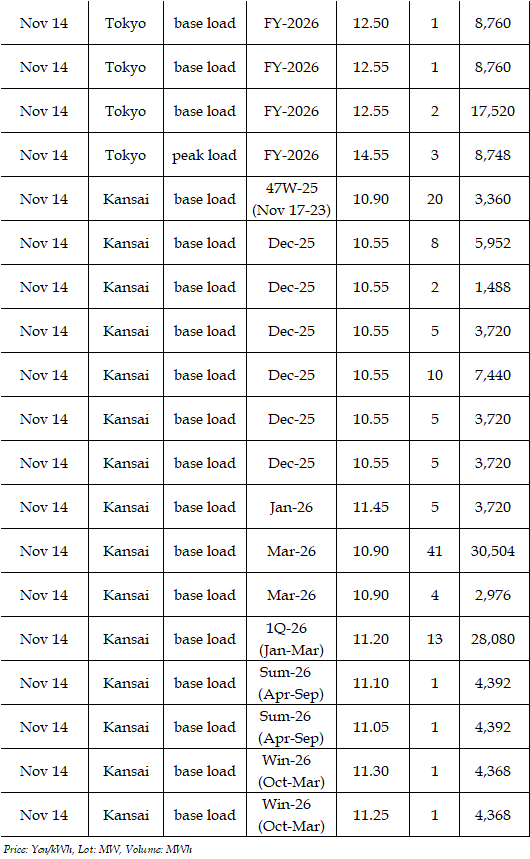Power: Nov 10-14: Spot price rebounds on market separation
|
In the day-ahead market on JEPX (Japan Electric Power Exchange), the 24-hour spot power prices on a weekly average basis for Nov 10-14 delivery rebounded from the previous week in East Japan (50 Hz) as well as in West Japan (60 Hz).While prices in East Japan did not change much from the previous week, those in West Japan were pulled up by the market separation. An increase in the market separation between Hokuriku and Kansai made it difficult for cheaper power generated in and to the west of the Kansai area to flow into the Chubu and Hokuriku areas, where prices saw a larger move to hike the overall West Japan market.
The spread of the 24-hour spot average between Tokyo and Kansai, a major market area in East and West Japan, was Yen 1.32 on Nov 10, Yen 3.74 on Nov 11, Yen 2.93 on Nov 12, Yen 1.81 on Nov 13, and Yen 2.17 on Nov 14 in favor of the East.
The fuel market trends in the second week of November were detailed as follows.
DES Northeast Asia spot LNG prices on Nov 13 almost stayed sideways from the end of last week (Nov 7) to low-$11's per mmBtu for prompt December 2025 delivery. The price moved in tandem with the natural gas markets in Europe. Buying interests from many end-users in Northeast Asia were tepid because they said they had already finished procuring cargoes for the winter delivery. The Ministry of Economy, Trade and Industry (METI) announced on Nov 11 that Japan's LNG inventories for power generation stood at 1.96 mil mt as of Nov 9, down 20,000 mt from a week before. The figure was above the end of November last year (1.72 mil mt) but below the average for the past five years (2.05 mil mt).
FOB Newcastle thermal coal prices in Australia were in the high-$109's per ton for November 2025 loading as of Nov 13, down around $0.5 from the end of the previous week.
In the crude oil market, WTI crude for December 2025 stood in the mid-$59's per barrel at 3PM on Nov 14, while Brent crude for January 2026 was trading in the high $63's. Prices dropped by about $0.25 from the end of the previous week for WTI and Brent. The reopening of the US government pushed the crude market up in the first half of the week; however, the monthly report published by the OPEC on Nov 12 indicated that the world crude market would have a surplus of 20,000 barrels per day, inducing a short in the crude futures and then sending the market in the second half of the week to the level below the previous week.
The actual highest price during the week was at Yen 18.52 in three East Japan areas and the system price on Nov 12; the actual lowest price during the week was at Yen 0.01 in Shikoku & Kyushu on Nov 10, in Shikoku on Nov 11, and in Kyushu on Nov 14.
By area, the weekly average of the 24-hour spot prices was at Yen 11.40 in Hokkaido, down Yen 1.76 from the previous week; Yen 11.18 in Tohoku, down Yen 0.06; Yen 12.95 in Tokyo, down Yen 0.85; Yen 12.66 in Chubu, up Yen 2.09; Yen 12.52 in Hokuriku, up Yen 2.72; Yen 10.56 in Kansai, up Yen 0.76; Yen 10.56 in Chugoku, up Yen 0.91; Yen 8.80 in Shikoku, up Yen 0.68; and Yen 10.00 in Kyushu, up Yen 0.94.
In the JEPX auction, the volume of offers was 1,049.16 mil kWh on a weekly average basis, down 0.9% from the previous week. Meanwhile, bids on a weekly average basis were up 7.5% to 972.72 mil kWh. The weekly average of trade volumes recorded 726.62 mil kWh, up 0.7%.
Power demand in nine areas of Japan during Nov 10-14 was a combined 11,205.38 mil kWh, up 5.3% from 10,643.87 mil kWh during Nov 3-7. The figure was up/down 5.5% from the corresponding period a year earlier, which was 10,621.17 mil kWh during Nov 11-15, 2024, after day-of-week adjustment.
Deals reported on TOCOM (Tokyo Commodity Exchange) during Nov 10-14 were as below.
Deals reported on EEX (European Energy Exchange) during Nov 10-14 were as below.
Prices for the third week in November would likely stay almost the same from the second week. A spell of mild weather, except for North Japan, would curb heating demand. While high temperatures in and to the west of the Kanto area in the middle of the week were expected to be just 13 degrees around and then could increase demand for heating, few players have been wary about it because sunny weather being forecasted would produce plenty of outputs from photovoltaic power plants. Asked about the outlook of the price in the third week, a source at a power producer and supplier said, "Prices would hover at low-mid Yen 13's in Tokyo; for Kansai, prices would be Yen 1-2 lower than the price in Tokyo. Thus, almost the same range as of the price in the second week."
|
||||||||||||||||||||||||||||||
|
|
||||||||||||||||||||||||||||||












